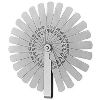I had read on various places the gap between the forcing cone and the cylinder when the action isn't locked up should be between 2-6 thousands of an inch.
I was checking a 2nd hand 629-1 and the gap seemed extremely tight so I asked the store owner if the gunsmith could measure it - it came back as .02mm or .00078".
So I passed on the revolver. The owner said it was perfectly okay. I don't know a great deal but thought a session at the range with 100-150 44 mag cartridges might be enough to heat the cylinder and lock up the action.
I'm looking for any information that might help to better understand this gap. I don't know if I was right, .00078" seemed extremely tight.
Many thanks.
I was checking a 2nd hand 629-1 and the gap seemed extremely tight so I asked the store owner if the gunsmith could measure it - it came back as .02mm or .00078".
So I passed on the revolver. The owner said it was perfectly okay. I don't know a great deal but thought a session at the range with 100-150 44 mag cartridges might be enough to heat the cylinder and lock up the action.
I'm looking for any information that might help to better understand this gap. I don't know if I was right, .00078" seemed extremely tight.
Many thanks.



